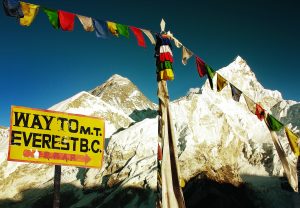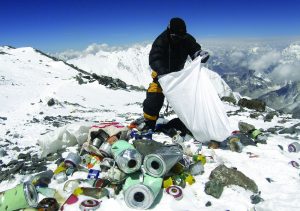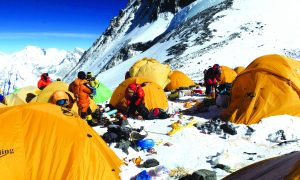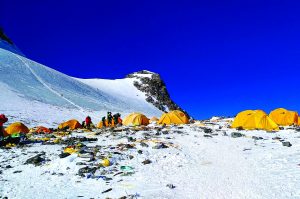 When Sherpa Tenzing Norgay and Sir Edmund Hillary stepped on Everest for the first time in the world 64 years ago, they would not have imagined that one day this beautiful mountain would be discussed for its garbage. Today, tonnes of garbage have been deposited on this highest mountain of the world and it is being seen as a major threat in terms of environment. The Mount Everest is bleeding and it has become the mountain of a problem because of the human waste, the leftover camping meals, beer and fuel cans, but human excrement or poo, too. There are reports of increasing cases of intestinal and diarrhea among climbers because of the tonnes of trash strewn across the world’s highest peak.
When Sherpa Tenzing Norgay and Sir Edmund Hillary stepped on Everest for the first time in the world 64 years ago, they would not have imagined that one day this beautiful mountain would be discussed for its garbage. Today, tonnes of garbage have been deposited on this highest mountain of the world and it is being seen as a major threat in terms of environment. The Mount Everest is bleeding and it has become the mountain of a problem because of the human waste, the leftover camping meals, beer and fuel cans, but human excrement or poo, too. There are reports of increasing cases of intestinal and diarrhea among climbers because of the tonnes of trash strewn across the world’s highest peak.
Now research published in the Global Change Biology Journal in January has revealed that the rising temperature is accelerating grass growing on Mount Everest, which has put environmental experts around the world in deep worries. One of the major causes of concern is the speed of melting of Himalayan glaciers has doubled in this century.
Not only the streets and drains of the world, but also the world’s highest peak is now in the grip of garbage. The part in which the temperature has increased, that part of Everest has started filling with grass and bushes. The side effect of this can be that due to excessive melting of ice, the flood situation and water shortage will occur. This claim has also been made in research published in the Global Change Biology Journal. According to this, more than 140 crores of people worldwide may have to face the shortage of water from the mountains.
These threats related to Everest are not limited to a pre-defined area. As a large number of people go there for mountain adventures, it is becoming a kind of picnic spot. This widens to the scope of vulnerabilities. So far, 8,310 people have climbed Mount Everest, which has an altitude of 8,848 meters. Their number has grown rapidly in past years. Last year alone, a total of 802 people climbed the summit of Everest.
The crowd scatters a lot of garbage, which is accumulated in the form of human feces, food packets, cylinders, dead bodies etc. The Nepal government launched a cleanliness drive last year for this world’s tallest short. The expedition was started in mid-April last year, in which there was a team of 12 Sherpas specializing in climbing, in which it collected garbage in about 35 days.
During the campaign, 11,000 kg i.e. 11 tonnes of garbage was removed from there. Apart from this waste, four bodies were also found. About 2.30 crore were spent on the campaign. But this is only a small part of the waste stored there. According to an estimate, about two lakh kilos of garbage have been deposited on Everest as on date. Human intervention is causing a lot of damage to the environment on Everest. A lot of garbage has been removed in the campaigns so far, but there is still a mountain of garbage there.
Seven years ago, Nepal made a rule that the team of mountain climbers would have to deposit two and a half lakh rupees and this amount would be refunded to the climber who brought back at least eight kg of garbage with them. The good thing is that it has yielded positive results. According to the Sagarmatha Pollution Control Committee, Kathmandu which does this, it has so far helped bring down large amounts of garbage and human waste. According to the Everest Summiteers Association, which has in recent years, taken tonnes of debris off the mountain, there are still about 30 tons of trash left on the mountain. The cleanup may only be a temporary solution to the garbage problem with thousands of climbers ready to climb the peak, the abandoned waste piles will only grow.
You will be surprised to know that as of December, 2019, 310 people have lost their lives trying to reach the height of Everest, while the number of people who flag on the highest K-2 peak is only a little less than 306. Worried about the number of people climbing Mount Everest, the legendary British mountaineer Doug Scott appealed to the Nepal government that such a large number of people should stop allowing them to climb this mountain.
Scott, who has climbed 75 high mountains in Asia, warns that the Himalayas are no longer a place of peace and solitude and could have very dangerous consequences. In the last few months, 12 people have died trying to climb the Himalayas, which can be used to estimate the number of people trying to climb the Everest.
In the last year, about 840 people tried to measure the height of Everest, which is the largest number ever. Experts are now openly expressing concern about this number. Recently in a program held in Kathmandu of Himalayan Travel Mart-2019, a seminar was organized on the subject of “a limited number of climbers should be allowed to climb, keeping in mind the potential of mountains” in which experts from all over the world Expressed their concern on the issue.
Dandu Raj Ghimire, director general of Nepal’s tourism department, has recently received a statement in which he acknowledged that there has been great environmental concerns and criticisms from the international community that Nepal has shown no seriousness towards maintaining the beauty of Everest. .
The number of wealthy climbers from Everest is increasing. The garbage found there suggests that climbers are not keeping the environment there. They leave a large number of goods etc. there. These include damaged tents, waste equipment, empty gas cylinders and human waste. Out of the 11 tonnes of garbage that was removed in last year’s cleanliness drive, seven tonnes were collected from Everest base camp and high altitude camps. While the rest of the garbage was collected from Lukla and Namche Bazaar villages called the entrance of Everest. This can explain the seriousness of the case.
Mount Everest opens only during the two-month season every spring. During this time, many enthusiasts try to conquer Mount Everest. However, during their efforts, these people leave trash on the Everest route. In his book climber Mark Jenkins wrote that two major routes, the Northeast Ridge and the Southeast Ridge, are not only dangerously crowded but have also been severely polluted.
In a similar warning, Chairman of Nepal Mountaineering Association Ang Tshering said that pollution on the Everest, especially human excreta, has reached dangerous levels and can spread the disease to the world’s highest peak. Once the climbers take the drums of the toilet, they empty it there. Climbers make a big hole in the ice for defecation and leave it open.
This filth has been accumulating there for years. It is a matter of concern that the Nepalese government has not been able to develop any concrete strategy for disposing of human waste left by the climbers there. Studies show that human excretion on Everest is more than 26,500 pounds in just one season.
By the way, Everest and mountaineering are known as a major means of Nepal’s economy. Very few people will know that the income from mountaineering is about five percent of the total GDP of Nepal. Now the rich people have started going there to have fun too. In fact, Nepal’s mountaineering department provides guides for hobbyists in exchange for money for climbing Everest. It started in the year 1990, but in the beginning, so many people did not go. For this, around 24.30 lakhs to 52.10 lakhs per person are charged. These guides are responsible for many tasks, including making route in the snow through rope and folding ladder. Apart from this, these guides also prepare food.
However, environmental experts are concerned with this. They says that by making it an entertainment thing, the environment is going to suffer a lot. There are 18 climbing routes to reach the summit of Everest. However, there are two of these where the number of these amateur climbers is more. The wealthy love to go through these two routes. This has made the situation dangerous. In the year 2014 and 2015 about 38 people lost their lives while trying to climb Everest. In fact, due to earthquake in 2015, many climbers have become grasps of time in the base camp itself.
Rapid growth of grasses and shrubs on Everest
The study report, ‘’Vegetation expansion in the subnival Hindu Kush Himalaya’’ by first authors Karen Anderson and Dominic Fawcett, published in Global Change Biology Journal, revealed the rapid growth of grasses and shrubs on Everest. This study has been done by dividing the total height of Everest into four parts. According to this, the maximum grass/vegitation/shrubs are growing in the height of 16 to 18 thousand, while in three other parts it has been seen growing. The melting condition of the Himalayan glaciers is that in the last four decades more than a quarter of the snow has melted there. Growing temperatures have been considered the most reason for grass growing there. According to the researchers, it is difficult to tell about its widespread damage, but the snow and grass growing between the trees can be helpful in increasing the flood in the Hindu-Kush Himalayas. Although the supply of water from the glacier is not that much, but the floods can make the already bad situation worse. According to the study published in the journal, there are some areas in the Himalayas where previously no vegetation was grown and there was snow every year. But studies show that more water is coming in these places, due to which vegetation has started to flourish.
According to researcher Karen Anderson, the ecosystem there is vulnerable to climate change. She says that the Himalayan glacier melting rate has doubled between 2000 and 2016. She expresses concern that it is very important to understand and monitor the loss of snow on the mountains. According to Karen, the speed at which small plants surround the snowy part of the Himalayas should be viewed as bad news. She says that rapid melting of frozen ice on plants directly means increased risk of flooding. Everest generates 10 major rivers of Asia quenching the thirst of about one and a half billion people. According to research conducted by researchers at University of Exeter in Britain with the help of photographs taken from NASA’s Landset Satellite from 1993 to 2018, the grass is growing at an altitude of up to 6000 meters above sea level. Snow is disappearing on the main mountains. Even if it is a large area, it should be monitored. It is not possible for new plants to grow at an altitude of 20 thousand feet. The reason is that snow does not grow at this height due to snow. One of the heating regions, this area is one of the fastest heating regions in the world. The most disturbing thing is the melting of glaciers. This is also visible in NASA photographs. In these pictures, the blue color gives the status of 1993, while in 2017, the red color there shows how fast the grass has grown there. Scientists have taken photographs of the grass and small bushes that grow there during the snowfall.
Nepal plans to remove waste
 The Government of Nepal is now planning to remove the waste collected on Everest and its other peaks in the route. Army will also help in this plan. A plan has been set to clear about 35,000 kg of garbage in the Nepal government’s plan for an ambitious cleaning campaign. Although thousands of tons of garbage has been accumulated on this world’s highest mountain, but this campaign will help a lot in reducing it.
The Government of Nepal is now planning to remove the waste collected on Everest and its other peaks in the route. Army will also help in this plan. A plan has been set to clear about 35,000 kg of garbage in the Nepal government’s plan for an ambitious cleaning campaign. Although thousands of tons of garbage has been accumulated on this world’s highest mountain, but this campaign will help a lot in reducing it.
According to the Nepal government’s plan, about 860 million of Nepalese rupees (about 53.93 crores of Indian rupees) will be spent on this whole campaign. The Nepali army is also preparing for this operation. This time the cleanliness campaign is to be conducted in the high altitude area of Everest, so both climbers and environmentalists are excited about it.
Previously this cleanliness campaign has been carried out in some low-lying areas. One reason for this is also that the high altitude area is very difficult and only expert Sherpa can go there. Anyway, most of Everest is very difficult terrain and it is difficult to climb there, cleaning is even more difficult.
According to the information of the “Tehelka” correspondent, this cleaning campaign will start in late April. It has been planned to complete it till June 5 as per the plan so far. Although in the past, the army has been involved in such operations, but this time it is being added on a large scale and the area of cleanliness will also be very high.
Apart from the main minor routes of Everest, some other peaks of this mountain have also been included in this cleanliness drive. Experts believe that this will help in working the waste on Everest to some extent.
Kami Rita Sherpa of Nepal, who has recorded Everest on record 24 times and twice in a short span of time last year, believes that the government’s plan is good but only experienced people should be engaged in this task. He have always said that the Sherpas to whom the government gives this responsibility do not have the necessary experience of climbing and cleaning.
Kami has also been saying that the government should set up a team of experienced Sherpa guides and porters for this task as no one else can do it better than them. They are also in favor of giving proper amount to these people because according to them it is not only hard work but also a risky job.
 The government is also considering a more stringent ban on climbers going to Everest on plastics that are single use. Apart from the incentive scheme, it is also being considered to be added to the manual.
The government is also considering a more stringent ban on climbers going to Everest on plastics that are single use. Apart from the incentive scheme, it is also being considered to be added to the manual.
On the way to Everest, the bodies of climbers who have died during the expeditions have also been collected. It is also interesting to mention here that the temperature of the Everest is there, the body does not rot for 98 years. A “death zone” has been identified in the route of Everest, which is up to 8000 meters height. There is also the fact that one out of every 10 climbers on the summit is unable to return to the main base camp, which can explain the danger of mountaineering on this mountain.
There are more than one route to climb Everest. A high steep cliff located on the main route of climbing collapsed during the 2015 Nepal earthquake. This has made this road more dangerous. In 1953, when Sir Edmund Hillary and Tenzing Norgay first stepped on Everest, this rock has since been known as “Hillary Step”.
This rock was located near the southeast peak and was about 12 meters in height. This is considered a very difficult trek for climbers. It is said that after the collapse of this rock, some changes have been seen in this route, which is a new experience for the mountaineers who have gone before. The collapse of this has ended the steep climb but a steep slope has been made for landing, making it risky.
Of all the routes to go to Everest, all of them have garbage. Many people do not go to K-2 and work only at high peaks. Hence garbage has accumulated in each and every part of these peaks.
People’s greed is also responsible for Everest’s bad condition. In 2007, due to its stubbornness to make the Olympic event grand, China had built a paved road at a height of 17,060 feet till the base camp of Everest. By the way, there was the first rough paved road on which the climbers used to trek to the base camp.
Not only this, China is said to have plans to build a track from within Everest to connect Nepal with road and rail. It has already built the world’s highest rail route to Lhasa (Tibet). In this way, this ambition of China is knocking many people because they believe that Everest is not the legacy of any one country and it is the gift of nature to the world.
Apart from the burden of waste to the Himalayas, there is a big risk of this ambition of China etc. Everest is considered to be a very delicate mountain range and its ecology. In such a situation, such construction in the foothills of the world’s highest peak can pose a great threat to the Himalayas. Due to human greed, glaciers of Himalayas are already collapsing and mountains are cracking. Therefore, this Chinese effort will be called very dangerous. This danger can only be avoided if governments and environmentalists, organizations unite.
 The increasing pressure on Everest is very worrying. Garbage is accumulating there, the number of people is also increasing, which is not good. The signs of debris accumulating there and the study we have done on its damage are very alarming. About 11 lakh liters of tapa urine have been deposited on Everest. Apart from this, the way polythene, plastic, food packets and empty bottles and even the bodies are being collected are very dangerous for Everest. There is no limit to helicopter waste. We demand that unless Everest is made waste-free, mountaineering activities should be stopped there. Alternatively, new peaks should be explored for mountaineering. There is a need for a war cleaning campaign on Everest, otherwise it will not be able to save anyone from ending it, and we humans will have to bear its biggest cost.
The increasing pressure on Everest is very worrying. Garbage is accumulating there, the number of people is also increasing, which is not good. The signs of debris accumulating there and the study we have done on its damage are very alarming. About 11 lakh liters of tapa urine have been deposited on Everest. Apart from this, the way polythene, plastic, food packets and empty bottles and even the bodies are being collected are very dangerous for Everest. There is no limit to helicopter waste. We demand that unless Everest is made waste-free, mountaineering activities should be stopped there. Alternatively, new peaks should be explored for mountaineering. There is a need for a war cleaning campaign on Everest, otherwise it will not be able to save anyone from ending it, and we humans will have to bear its biggest cost.
—Junko Tabei, Japan, the first woman to climb Everest
Interesting facts about Everest
It takes about 40 days for climbers to climb Mount Everest and understand and adjust
the altitude and temperature there.
There the wind speed reaches 321 km/hour. There the temperature goes down to minus 80 degrees Fahrenheit. It is believed by scientific research that this mountain increases by four millimeters every year.
Yuichiro Miura is the oldest person to climb the Everest. When he reached Everest, he was 80 years old while Jordan Romero is the youngest person to conquer Mount Everest. He climbed Everest at the age of 13.
Very few people would know that theft takes place beyond Everest too. Yes, many foreign climbers who climb the world’s highest peak have complained of theft of oxygen cylinders.
Is there snow man in the Himalayas!
Snow man or The Yeti. Whenever there is talk of Himalaya, there is also mention of The Yeti. A few months ago, the Indian Army tweeted some pictures showing giant footprints on
the snow.
These nishas were up to 32×15 inches in size. After this, discussion started again about the presence of snowman in the Himalayas. Whenever there is talk of mystical beings in the world, ‘Yeti’ is definitely mentioned. By the way, the story of Yeti is very old. There have been claims to see Yeti many times. The Buddhist monasteries of Ladakh also claimed that they had seen the snowman. However, researchers do not consider “Yeti” as human. According to him, it is actually a cross breed of polar and brown bears.
According to some scientists, Yethi is a giant creature, whose appearance is like monkeys, but it walks on two legs like humans. The first time in modern times was claimed to see “snowman” in 1921.
A group of British explorers, interviewed by a journalist named Henry Newman, claimed during interviews that they saw giant footprints on the mountain. Since then, there have been dozens of researches on Yeti, but nothing has been cleared.
The most prominent trend of growing vegetation on Everest has been seen between 5000 and 5500 meters elevation. At higher elevations, the expansion was more in the flat areas while in the lower levels it was higher in the slopes. The big question is what does this change in vegetation mean for hydrology (water properties) in the area? Will this halt the melting of glaciers and ice sheets, or will it speed up the process? The Hindu Kush Himalayan region extends from Myanmar in the east to Afghanistan in the west in eight countries. More than 140 crore people of this region depend on it for water, so change cannot be taken lightly.
—Karen Anderson & Dominic Fawcett, Researchers
Kami Rita climbs Mt Everest for record 24th time
Nepal climber Kami Rita Sherpa has climbed Mount Everest 24 times and is a world record. In the year 2019, they climbed Everest twice. He want to make this world’s highest peak record for 25 times. Kami Rita climbed Everest for the first time in the year 1994 and at that time he was only 24 years old. He often climbs Everest every year. In the year 2019, he broke his own record of climbing the highest peak in the world by climbing Mount Everest. Kami Rita, who hails from Thame village of Solukhumbu district in Nepal, became the third person to climb Mount Everest for the 21st time in 2014. Before him, this feat was done by Apa Sherpa and Furba Tashi Sherpa.













